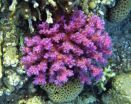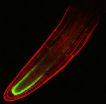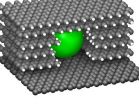(Press-News.org) New research by the University of Southampton has found a mechanism as to how corals use their pink and purple hues as sunscreen to protect them against harmful sunlight.
Many reef corals need light to survive, as they benefit from sugars and lipids that are produced by their light-dependent symbiotic algae. However, in the shallow water of coral reefs, light levels are often higher than required by the corals, so paradoxically, the vital sunlight can become harmful for the algae and their hosts.
Apart from temperature, light stress is a major driver of coral bleaching – the loss of the symbiotic algae that represents a threat to coral reef survival.
Working in the Great Barrier Reef and under tightly controlled conditions in the Coral Reef Laboratory of the University of Southampton, the team of researchers produced experimental evidence that the pink and purple chromoproteins can act as sunscreens for the symbiotic algae by removing parts of the light that might become otherwise harmful.
Dr Jörg Wiedenmann, Senior Lecturer of Biological Oceanography and Head of the University's Coral Reef Laboratory, who led the study says: "The beautiful pink and purple hues that are produced by the coral host are often evoked by chromoproteins; pigments that are biochemically related to the green fluorescent protein (GFP) of the jellyfish Aequorea victoria. In contrast to their green glowing counterpart, the chromoproteins take up substantial amounts of light, but they don't re-emit light.
"GFP-like proteins were suggested to contribute to the protection of corals and their symbionts from excess sunlight. This hypothesis has been controversially discussed as the mechanism as to how these pigments function remained unclear. At least for the chromoproteins we know now that they have indeed the capacity to fulfill this function."
The researchers also proposed an explanation for the mysterious phenomenon that some corals accumulate exceptionally high amounts of chromoproteins in growing areas, such as branch tips or in the region of healing wounds.
Dr Wiedenmann, who is based at the National Oceanography Centre, Southampton, explains: "These growing areas contain essentially no symbiotic algae, so much of the light is reflected by the white coral skeleton instead of being used by the algae. The resulting increased light intensities in the new parts of the coral represent a potential danger for the algal cells that need to colonise these areas. Hence, it seems that the corals use a clever trick to help their symbionts. The higher light intensity switches on the genes that are responsible for the production of the sunscreening chromoproteins.
"Our results suggest that the screening effect of the chromoproteins could help the algae to enter the new tissue. Once the symbiont population is fully established, the light levels in the tissue decrease as the algae use most of the light for photosynthesis. As a consequence, the genes of the chromoproteins are switched off again which allows the coral to save the energy required for their production."
The research contributes to a better understanding of the coral's response to environmental stress. Knowledge of the stress resilience of corals is an important requirement to help predictions of the fate of coral reefs that are exposed to climate change and various forms of anthropogenic disturbance.
INFORMATION:
The paper is published in the latest edition of the journal Coral Reefs.
How the purple and pink sunscreens of reef corals work
2013-01-23
ELSE PRESS RELEASES FROM THIS DATE:
Santiago, Chile, will get drier and warmer
2013-01-23
This press release is available in German and Spanish.
Santiago de Chile/Leipzig. Already nowadays ten per cent or more of the population in the Metropolitan Region of Santiago de Chile is affected by extreme heat or floods. These threats will tend to increase due to the continuous expansion of the Chilean capital, the consequent changes in land use and the influences of climate change. Because of that, the international research project ClimateAdaptationSantiago (CAS) has developed, during the last three years, an Adaptation Plan to climate change for the metropolitan ...
Breakthrough: How salt stops plant growth
2013-01-23
Washington, D.C. —Until now it has not been clear how salt, a scourge to agriculture, halts the growth of the plant-root system. A team of researchers, led by the Carnegie Institution's José Dinneny and Lina Duan, found that not all types of roots are equally inhibited. They discovered that an inner layer of tissue in the branching roots that anchor the plant is sensitive to salt and activates a stress hormone, which stops root growth. The study, published in the current issue of The Plant Cell, is a boon for understanding the stress response and for developing salt-resistant ...
Reinventing retirement: New pathways, new arrangements, new meanings
2013-01-23
Retirement involves a set of institutional arrangements combined with socio-cultural meanings to sustain a distinct retirement phase in life course and career pathways. The articles outline that recent forces of change may lead to reinvention of retirement. There are factors that must be recognized as having a significant impact such as the fact that life expectancy and health status of adults over 60 has increased dramatically in recent years. Reinvention could involve change to one or more of the institutional arrangements supporting retirement. New financial risks and ...
Nanoparticles digging the world's smallest tunnels
2013-01-23
This press release is available in German.
The world's smallest tunnels have a width of a few nanometers only. Researchers from Karlsruhe Institute of Technology (KIT) and Rice University, USA, have dug such tunnels into graphite samples. This will allow structuring of the interior of materials through self-organization in the nanometer range and tailoring of nanoporous graphite for applications in medicine and battery technology. Results are now presented in the scientific journal Nature Communications (DOI: 10.1038/ncomms2399).
The tunnels are manufactured applying ...
Researchers create self-healing, stretchable wires using liquid metal
2013-01-23
Researchers from North Carolina State University have developed elastic, self-healing wires in which both the liquid-metal core and the polymer sheath reconnect at the molecular level after being severed.
"Because we're using liquid metal, these wires have excellent conductive properties," says Dr. Michael Dickey, an assistant professor of chemical and biomolecular engineering at NC State and co-author of a paper on the work. "And because the wires are also elastic and self-healing, they have a lot of potential for use in technologies that could be exposed to high-stress ...
Learn to be more understanding by watching The Bachelor (this season, anyway)
2013-01-23
A new USC study finds evidence suggesting that the brain works hard to understand those who have different bodies when watching them in action.
According to the study's lead author, the finding supports initiatives to include more individuals with physical differences in mainstream media – such as Sarah Herron, a contestant on ABC's The Bachelor this season, who was born with a foreshortened left arm.
"Generally, it's considered impolite to stare. But what these results suggest is that we need to look. It's through this visual experience that we're able to make sense ...
New way to identify 'smoked' grapes and wines
2013-01-23
With climate change sparking concern about an increased risk of wildfires, scientists are reporting development of a way to detect grapes exposed to smoke from those fires, which otherwise could be vented into bad-tasting wine. Their report on the method for detecting smoke taint in both grapes and wine appears in ACS' Journal of Agricultural and Food Chemistry.
Yoji Hayasaka and colleagues point out that Australia and other areas of the world are experiencing an increase in bush and wildfires, which may continue and intensify with global climate change. Smoke from those ...
Scientists underestimated potential for Tohoku quake. Now what?
2013-01-23
CORVALLIS, Ore. – The massive Tohoku, Japan, earthquake in 2011 and Sumatra-Andaman superquake in 2004 stunned scientists because neither region was thought to be capable of producing a megathrust earthquake with a magnitude exceeding 8.4.
Now earthquake scientists are going back to the proverbial drawing board and admitting that existing predictive models looking at maximum earthquake size are no longer valid.
In a new analysis published in the journal Seismological Research Letters, a team of scientists led by Oregon State University's Chris Goldfinger describes how ...
Putting the squeeze on cells
2013-01-23
CAMBRIDGE, Mass. — Living cells are surrounded by a membrane that tightly regulates what gets in and out of the cell. This barrier is necessary for cells to control their internal environment, but it makes it more difficult for scientists to deliver large molecules such as nanoparticles for imaging, or proteins that can reprogram them into pluripotent stem cells.
Researchers from MIT have now found a safe and efficient way to get large molecules through the cell membrane, by squeezing the cells through a narrow constriction that opens up tiny, temporary holes in the membrane. ...
Panel recommends changing name of common disorder in women
2013-01-23
An independent panel convened by the National Institutes of Health has concluded that the name of a common hormone disorder in women, polycystic ovary syndrome (PCOS), causes confusion and is a barrier to research progress and effective patient care. The current name focuses on a criterion — ovarian cysts — which is neither necessary nor sufficient to diagnose the syndrome. In a report released today, the panel recommended assigning a new name that more accurately reflects the disorder.
"The name PCOS is a distraction that impedes progress. It is time to assign a name ...




